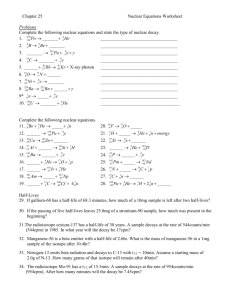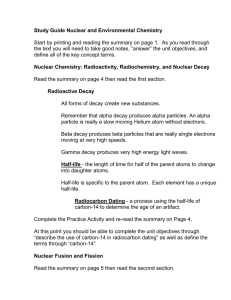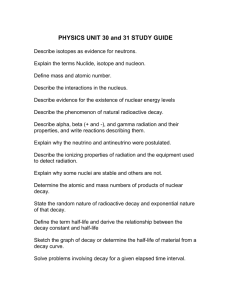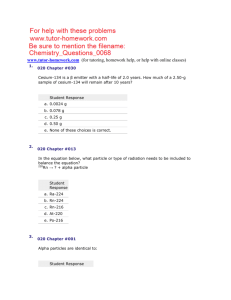Authentic Radioisotope Experiments
advertisement
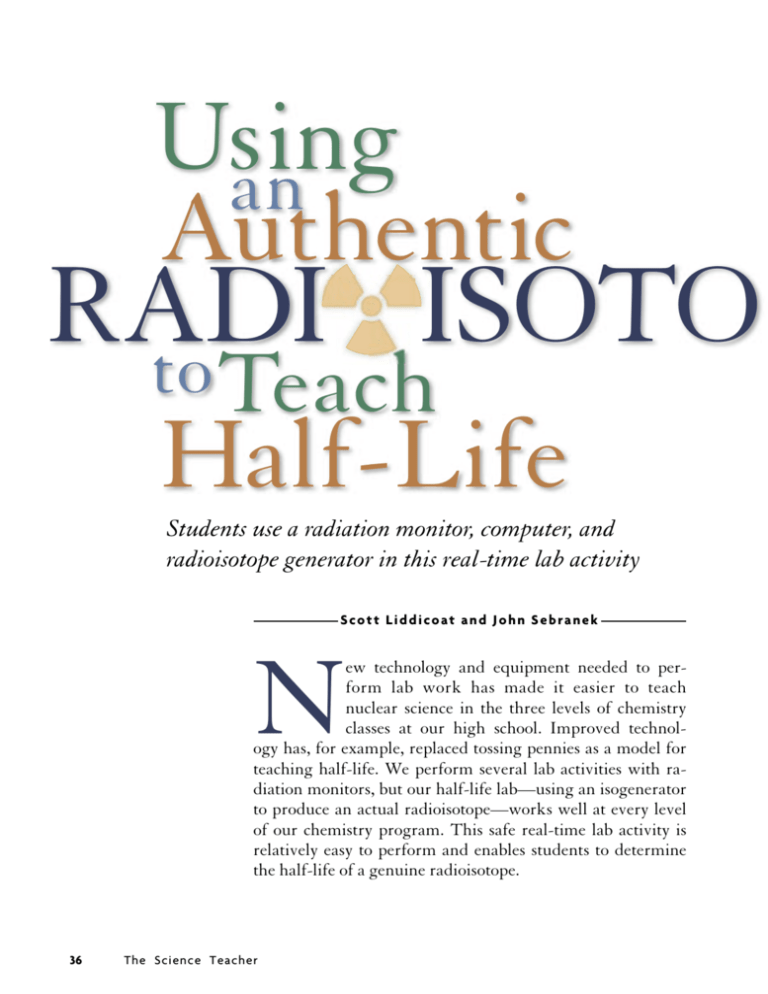
Using g an Authentic A t RADI ISOTO to Teach Half-Life lf- Students use a radiation monitor, computer, and radioisotope generator in this real-time lab activity S co t t L i d d i co at a n d J o h n S e b ra n e k N ew technology and equipment needed to perform lab work has made it easier to teach nuclear science in the three levels of chemistry classes at our high school. Improved technology has, for example, replaced tossing pennies as a model for teaching half-life. We perform several lab activities with radiation monitors, but our half-life lab—using an isogenerator to produce an actual radioisotope—works well at every level of our chemistry program. This safe real-time lab activity is relatively easy to perform and enables students to determine the half-life of a genuine radioisotope. 36 The Science Teacher PHOTOS COURTESY OF THE AUTHORS PE Students observing the radioactive decay of Ba-137m as data is collected on their computer. December 2005 37 Teaching nuclear chemistry Traditionally nuclear chemistry appears in the last few chapters of chemistry textbooks and is not normally considered a mainstream topic. In addition, some science teachers lack the training or equipment to teach nuclear chemistry. Yet nuclear chemistry is a very important topic that should be taught in all chemistry classrooms. Standards relating to nuclear chemistry are found in the National Science Education Standards (NRC 1996, p. 62), most state science standards, and in our school district curriculum (Green Bay Area Public School District 2005). Learning about nuclear chemistry concepts and investigating radiation in the laboratory helps students overcome their sometimes irrational fear of radiation. This lab helps students develop the thinking necessary to consider societal issues, such as the irradiation of food, the true relative risk of an x-ray, or the future of nuclear power. It may also open up productive vocational choices to them—millions of jobs in today’s economy either use or depend on radiochemistry (NMC 2002). The concept of half-life Different radioactive isotopes decay and emit radiation at different rates. Scientists have determined a convenient way to measure and report how fast various radioactive isotopes (radioisotopes) decay. The rate of decay of a radioisotope is measured by its half-life. One half-life is the time it takes for one-half of the atoms of a radioactive isotope to decay to its product (Figure 1). The half-life of a radioisotope plays a role in almost every application of nuclear chemistry. Radioisotopes are used in medical research, diagnosis, and treatment; nuclear power; consumer product research, analysis, and production; the preservation of fresh food; age estimates of ancient organisms and artifacts; power for deep-space probes; sterilization of medical instruments; and much more. For example, technetium (Tc) is widely used in FIGURE 1 Some radioisotopes and their half-lives (Serway 1990). 38 Radioisotope (decay type) Half-life U-238 (α) 4,468,000,000 years Po-214 (α) 0.000164 second Bi-210 (β) 5 days C-14 (β) 5730 years Po-210 (α) 138 days Sr-90 (β) 28.6 years Co-60 (β,γ) 5.27 years Ba-137m (γ) 153 seconds The Science Teacher FIGURE 2 Student eluting Ba-137m isotope into a well plate from an isogenerator capsule with dilute salt solution. medical applications. With a half-life of six hours, technetium is used by many hospitals as a diagnostic tool. Technetium isotopes can be tagged to a substance so that when they are ingested orally or injected into the body, the isotopes will travel to the region of the body that doctors want to study. For instance, to study blood flow through a patient’s liver, a doctor might mix the technetium with a colloid because one of the functions of the liver is to remove large macromolecules such as colloids from the blood. A nuclear scanner interfaced to a computer generates clear images of the blood flow inside the body, in this case the liver. FIGURE 3 Students print a graph of their decay data and determine the half-life of the Ba-137m isotope. FIGURE 4 Graph of isogenerator decay data plotting count rate versus time. This noninvasive approach to medical diagnosis has revolutionized the medical industry and eliminated the need for risky exploratory surgery. Most nuclear scanners detect best during the first half-life period of the isotope. Doctors use these images to make accurate diagnoses and treatment plans (Griswold 2004). The six-hour half-life of technetium is short enough to keep the radioactive risk to the patient to a minimum, but long enough to scan for a good image within the body. Determining half-life of Barium-137m in the lab FIGURE 5 Graph of isogenerator decay data plotting natural log of count rate versus time. Determining half-life experimentally is hard to do in an educational setting. It is difficult to isolate the radioactivity from just one radioisotope in a decay series, and student safety is a concern with the use of radioisotopes. However, the materials and equipment used to perform the following lab help to overcome these difficulties. The technetium used in hospitals is “milked” from a molybdenum (Mo) source in much the same way as teachers “milk” Barium-137m (Ba-137m) in the classroom from a mixture of barium and cesium isotopes stored in what is called an isogenerator. An isogenerator is a small plastic capsule that contains a series of radioisotopes that decay to a meta-stable isotope of barium (Ba-137m) (Canberra Corporation). We use an “eluting solution” to “milk” or “wash” just the Ba-137m away from all of the other radioisotopes in its decay series. The Ba-137m can be easily and repeatedly eluted from an isogenerator capsule using a dilute salt solution (0.10M NaCl) (Figure 2). Ba-137m decays by gamma emission to a stable, nonradioactive isotope of barium, Ba-137. The short half-life of Ba-137m (153 seconds) (Lide 2004) means that after one half hour the residual activity in the solution virtually disappears, making it safe for disposal using standard methods for soluble barium salts. The initial activity of the Ba-137m sample eluted from the isogenerator is less than 2 µCi (Spectrum December 2005 39 Techniques Corporation) and its radioactivity only a few minutes later is considerably lower. The isogenerator contains enough of the parent isotopes to be used repeatedly for many years. Only low intensity gamma radiation is emitted from the eluted solution of Ba-137m. This is detected using a radiation monitor connected to a computer or calculator-based interface. In 10–20 minutes students can obtain an enormous data set they can analyze directly or with a computer or graphing calculator. The data collected can be analyzed in different ways to determine the half-life of Ba-137m. The method selected will depend on class goals and the teaching time. At our school, students who do not plan to major in a science-related field in college take conceptual chemistry. Students taking this elective science class use a straightforward approach to calculating half-life. These students make a printout of their data, onto which a curve of best fit has been superimposed. Radiation count rates are plotted on the y-axis and time is plotted on the x-axis. By dividing initial radioactive count rates in half, and half again, and half again on the graph, students may determine the half-life of Ba137m with a good degree of accuracy (Figure 3, p. 38). For students taking regular (college-preparatory) chemistry and Advanced Placement chemistry, a different approach for determining half-life is typically used. The probeware’s data management software program is used to collect decay data on a computer. Students place an exponential curve fit to the decay data collected in the program to see how well their relationship fits a first-order rate equation (Figure 4, p. 39). Then students create a calculated column inside the program where they take the natural log of the count rate data. The natural log data is then plotted on the y-axis against time on the x-axis to create the graph in Figure 5 (p. 39). A plot of the natural log versus the count rate yields a scatter plot of data that appears very linear. Plotting a regression line through the data gives the slope or decay constant for the graph. This regression plot can be applied to the first-order rate equation to get: The slope or decay constant (k) is negative, reflecting the decrease in counts as the decay progresses. Many textbooks write half-life as a positive quantity, so we will write the half-life as a positive quantity in seconds for the loss of Ba-137m as it decays to Ba-137 stable isotope: ln Ao = kt = ln Ao - ln At = kt , which can be written in the form ln At Difficulties and concerns ln At = -kt + ln Ao , ln At = y, k = -m, t = x, ln Ao = b in y = -mx + b. The y-axis in Figure 5 represents the natural log of the count rate. The initial reading is symbolized by (A0). The natural log of the count rate at time t is equal to At. Based on our example above, the slope (m) is equal to the decay constant (k) where k = 0.693 t1/2 40 The Science Teacher t1/2 = 0.693 = 0.693 -1 = 157s. k 0.00442s The accepted half-life for Ba-137m is 2.552 minutes or 153 seconds. Clearly this lab can generate very accurate results. Over the years student data has been used to calculate the half-life of Ba-137m with under 5% error. Student assessment How do we know that our students understand the concept of half-life? Our chemistry students face paper-and-pencil assessments in which students plot raw data and determine half-life. Our laboratory write-ups contain questions progressively sequenced in difficulty to challenge our students. The questions that arise from students working with this assessment tool informally tell us that students usually understand the concept of half-life very well. (Write-ups with prelab, lab procedure, and postlab questions are available on our School Science website at http://home.new.rr.com/ swscience.) Beyond this, much is up to the teacher, the time available, and curriculum requirements for nuclear chemistry. The lab experience is much richer, more enjoyable, and more easily understood when taught in the context of a well-planned nuclear chemistry unit, rather than taught as a stand-alone lab. The implications of the concept of half-life are easier for students to grasp when the teacher can take the time to talk about medical, business, and consumer applications. For example, most students have known someone who has received radiation treatments for cancer or someone who has undergone a nuclear scan. They usually want to know more about these applications. When students can correctly tell us why one radioisotope is better to use than another in a particular application, or what length of half-life is appropriate in another application, we know they understand half-life decay. Each isogenerator can be eluted numerous times over many years. However, the isogenerator needs adequate time (about an hour) to regenerate Ba-137m after each use. For this reason the teacher with just one isogenerator may wish to do this activity as a demonstration, or at least wait several minutes between each elution. While waiting between elutions, the teacher must recognize that the maximum number of radioactive counts for each lab group after the first will be much lower, which increases the likelihood and range Despite the enormous number of nuclear science applications found around us, many of the fundamental concepts surrounding nuclear chemistry are misunderstood and even feared. of error in calculating the half-life of Ba-137m. We have overcome this difficulty by gradually purchasing an isogenerator for each lab station (approximately $230). Because the isogenerators are used with students at all three levels of chemistry, this is not as expensive as it may seem. This laboratory exercise is safe for students to perform. As mentioned earlier, Ba-137m has a very short half-life (153 seconds) and it decays quickly to a stable, nonradioactive isotope of barium. This makes for relatively risk-free student handling and safe disposal after 30 minutes. The quantity of barium disposed of in this way is considered insignificant from both an environmental and nuclear standpoint (NMC 2002; Canberra Corporation; Spectrum Techniques Corporation; Flinn Scientific 2005). Students should not get any of the liquid on their hands during the elution process as Ba-137m emits low intensity gamma radiation. When students wear chemical-resistant gloves and follow procedures (see School Science at http://home.new.rr.com/swscience, for the detailed laboratory procedure), there is little or no chance of spilling. We recommend that the teacher either perform the elution at each lab station, or personally supervise students as they do it. This will prevent any misuse of the isogenerator. Exposure to radiation during the lab activity is barely above background levels (Spectrum Techniques Corporation; Flinn Scientific 2005) for most students standing a couple of feet away from the Ba-137m isotope during the lab. This can be demonstrated to students with the instructor holding a radiation monitor a couple of feet away from the Ba-137m. Only background levels of radiation will be detected. There is virtually no radioactive risk to the student (and no radioactive risk to the developing child of a student who may be pregnant). For a population of welltrained students, this lab is very safe to perform. No specialized student safety equipment is needed beyond student goggles and vinyl gloves. After completing the radioactivity experiment, the teacher should store the isogenerator in a secure cabinet, which can be locked and is used for no other purpose (Spectrum Techniques Corporation). The radiation level inside the isogenera- tor has been tested by Spectrum Techniques to be less than 8 µCi. It requires no special storage or handling. It is standard practice to store chemicals and radioactive materials in separate, locked cabinets (Flinn Scientific 2005). Reviving nuclear science education Nuclear science has taken a back seat in today’s chemistry curriculum. Despite the enormous number of nuclear science applications found around us, many of the fundamental concepts surrounding nuclear chemistry are misunderstood and even feared. This half-life lab—especially when integrated into a well-planned unit on nuclear chemistry—will provide students with the knowledge to overcome misunderstanding and irrational fear. Students will be hitting important standards and benchmarks for the teaching of science and better preparing themselves for understanding and living in today’s world. ■ Scott Liddicoat (sliddico@greenbay.k12.wi.us) and John Sebranek (jsebrane@greenbay.k12.wi.us) are chemistry teachers at Green Bay Southwest High School, 1331 Packerland Drive, Green Bay, WI 54304. References Canberra Corporation. www.canberra.com. Flinn Scientific. 2005. Flinn chemical & biological catalog reference manual 2005. Batavia, IL: Flinn Scientific. Green Bay Area Public School District. 2005. www.greenbay.k12. wi.us/01/parents01/standards/hs/science/index.html. Griswold, R. 2004. Program Director of the School of Radiologic Technology, Bellin Hospital, Green Bay, WI. www.uscollegesearch. org/bellin_hospital_school_of_radiologic_technology.html. Lide, D.R., ed. 2004. CRC handbook of chemistry and physics, 85th edition. Boca Raton, FL: CRC Press. National Research Council (NRC). 1996. National science education standards. Washington, DC: National Academy Press. Nuclear Management Company (NMC). 2002. www.nmcco.com/education/facts/radiation/medical.html. School Science. 2005. http://home.new.rr.com/swscience. Serway, R.A. 1990. Physics for scientists and engineers. Philadelphia: Saunders College Publishing. Spectrum Techniques Corporation. www.spectrumtechniques.com. December 2005 41


